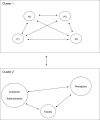Identifying perceptions of professionalism in pharmacy using a four-frame leadership model
- PMID: 19002288
- PMCID: PMC2576429
- DOI: 10.5688/aj720490
Identifying perceptions of professionalism in pharmacy using a four-frame leadership model
Abstract
Objectives: To determine whether professionalism in pharmacy education is addressed from Bolman and Deal's four-frame leadership model.
Methods: Students (N=624), faculty (N=57), preceptors (N=56), and academic administrators (N=8) at 6 colleges and schools of pharmacy were surveyed to assess professionalism. Using grounded theory methodology and a constant comparative process, common themes were identified for each question in each group. Themes were assigned to the four-frame model and the data were compared.
Results: Mechanisms of addressing professionalism consistent with all 4 frames of the Bolman and Deal's model were identified. Faculty assessment of student professionalism was significantly lower (P<0.05) than the student group, preceptors, and administrators.
Conclusions: Mechanisms of addressing professionalism in pharmacy education span all four frames of Bolman and Deal's leadership model. The values students bring into a pharmacy program may play an important role in the process of professional socialization. Faculty members have a tremendous opportunity to enhance student professionalism with their daily verbal and nonverbal interactions with students.
Keywords: faculty; leadership; pharmacy students; professionalism; qualitative research.
Figures
Similar articles
-
Identifying Priority Student Leadership and Professionalism Attributes Among Faculty, Preceptors, and Students via Modified Delphi.Am J Pharm Educ. 2020 Nov;84(11):8076. doi: 10.5688/ajpe8076. Epub 2020 Jul 31. Am J Pharm Educ. 2020. PMID: 34283754 Free PMC article.
-
Identifying perceptions of academic reform in pharmacy using a four-frame organizational change model.Res Social Adm Pharm. 2018 Oct;14(10):921-930. doi: 10.1016/j.sapharm.2017.11.006. Epub 2017 Nov 10. Res Social Adm Pharm. 2018. PMID: 29162326
-
The mindsets of medical education leaders: how do they conceive of their work?Acad Med. 2010 Jan;85(1):57-62. doi: 10.1097/ACM.0b013e3181c46e47. Acad Med. 2010. PMID: 20042823
-
Description of a novel co-curricular professional engagement program for student pharmacists.Curr Pharm Teach Learn. 2020 Sep;12(9):1062-1071. doi: 10.1016/j.cptl.2020.04.033. Epub 2020 May 21. Curr Pharm Teach Learn. 2020. PMID: 32624135 Review.
-
Best Practices for Self-Awareness and Professionalism to Meet the Curriculum Outcomes and Entrustable Professional Activities.Am J Pharm Educ. 2025 May;89(5):101404. doi: 10.1016/j.ajpe.2025.101404. Epub 2025 Apr 14. Am J Pharm Educ. 2025. PMID: 40239840 Review.
Cited by
-
Professionalism in pharmacy: a continual societal and intellectual challenge.Am J Pharm Educ. 2012 May 10;76(4):72. doi: 10.5688/ajpe76472. Am J Pharm Educ. 2012. PMID: 22611281 Free PMC article. No abstract available.
-
Early Introduction to Professional and Ethical Dilemmas in a Pharmaceutical Care Laboratory Course.Am J Pharm Educ. 2015 Dec 25;79(10):156. doi: 10.5688/ajpe7910156. Am J Pharm Educ. 2015. PMID: 26889068 Free PMC article.
-
Modeling Doctor of Pharmacy Students' Stress, Satisfaction, and Professionalism Over Time.Am J Pharm Educ. 2019 Nov;83(9):7432. doi: 10.5688/ajpe7432. Am J Pharm Educ. 2019. PMID: 31871360 Free PMC article.
-
Stakeholders' Perspectives on Quality Assurance of Pharmacy Education in the Eastern Mediterranean Region.Am J Pharm Educ. 2018 Dec;82(10):6482. doi: 10.5688/ajpe6482. Am J Pharm Educ. 2018. PMID: 30643311 Free PMC article.
-
Swedish students' and preceptors' perceptions of what students learn in a six-month advanced pharmacy practice experience.Am J Pharm Educ. 2011 Dec 15;75(10):197. doi: 10.5688/ajpe7510197. Am J Pharm Educ. 2011. PMID: 22345716 Free PMC article.
References
-
- Bradberry JC, Droege M, Evans RL, etal. Curricula then and now: an environmental scan and recommendations since the commission to implement change in pharmaceutical education. Report of the 2006-2007 American Association of Colleges of Pharmacy, Academic Affairs Committee. 2007 Available at: http://www.aacp.org/Docs/AACPFunctions/Governance/8442_GettingtoSolution... Accessed on August 4, 2007.
-
- American Pharmacists Association-Academy of Students of Pharmacy and the American Association of Colleges of Pharmacy Council of Deans. White paper on pharmacy student professionalism. J Am Pharm Assoc. 2000;40:96–102. - PubMed
-
- Hammer DP, Berger BA, Beardsley RS, Easton MR. Student professionalism. Am J Pharm Educ. 2003;67(3) Article 96.
-
- Lin A, Altiere R, Harris W. Leadership: the nexus between challenge and opportunity: Reports of the 2002-2003 Academic Affairs, Professional Affairs, and Research and Graduate Affairs Committees. Am J Pharm Educ. 2003;67(3) Article S05.
-
- Wells BG. Leadership for ethical decision making. Am J Pharm Educ. 2003;67(1) Article 3.
Publication types
MeSH terms
LinkOut - more resources
Full Text Sources

